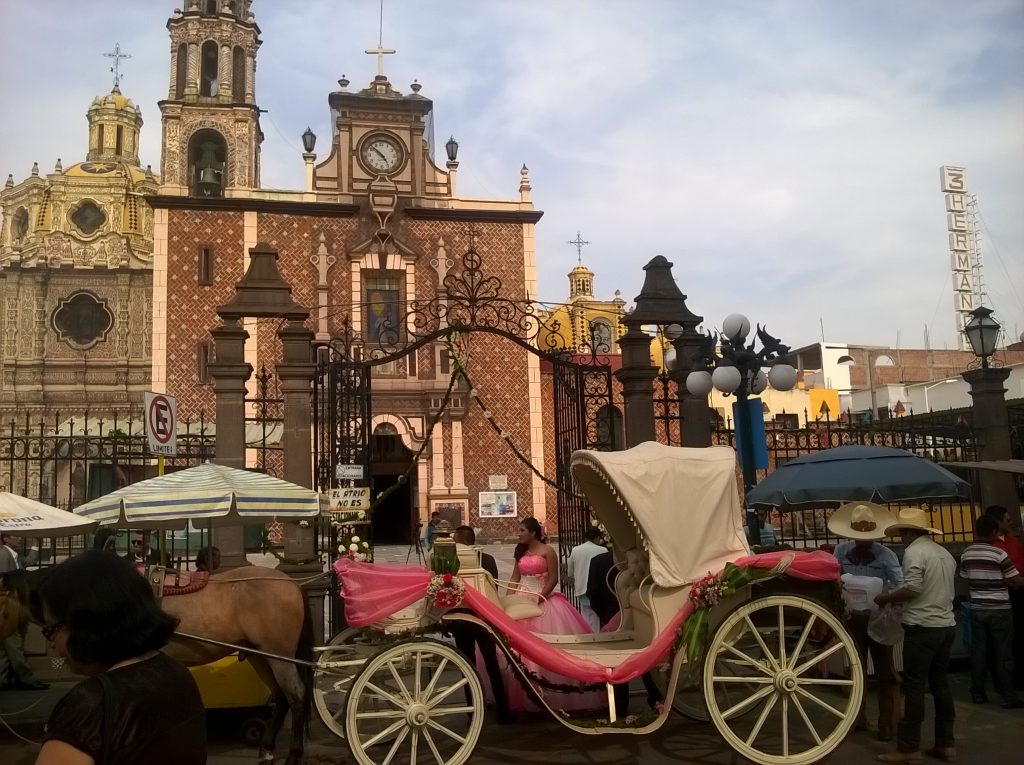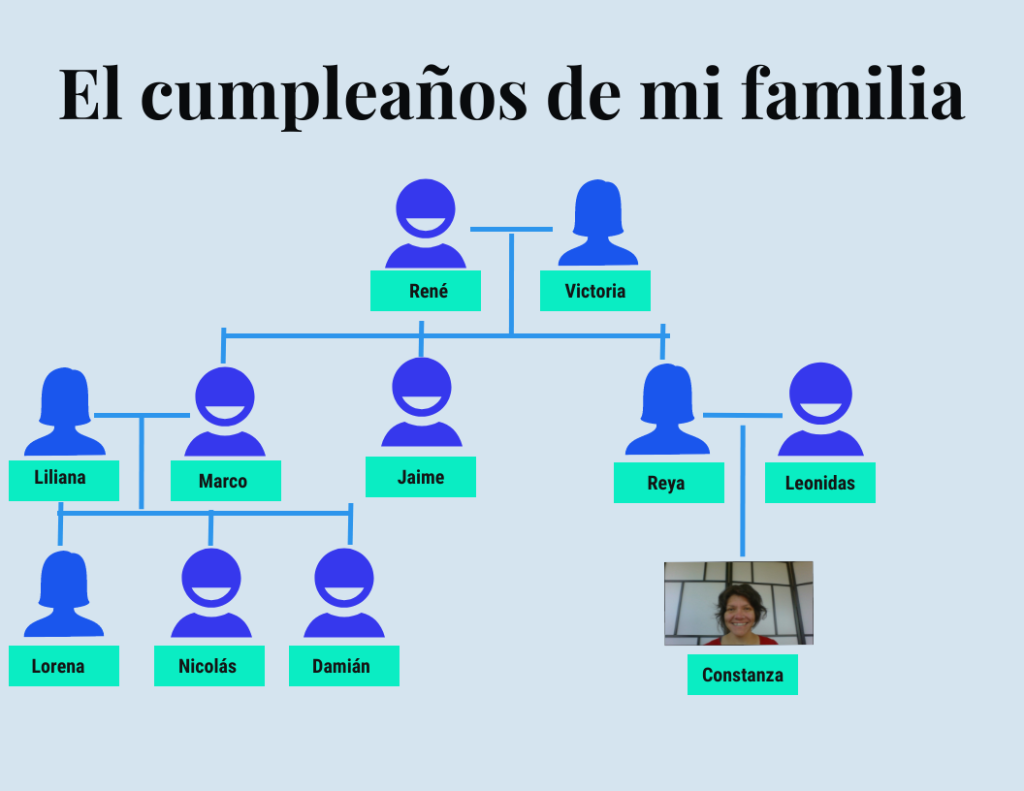Unidad 2 – Segunda Parte (Part 2)
Vocabulario
(Vocabulary)
Los meses del año (Months of the year)
| El año = 12 meses | ||
|---|---|---|
| 1
enero |
2
febrero |
3
marzo |
| 4
abril |
5
mayo |
6
junio |
| 7
julio |
8
agosto |
9
septiembre |
| 10
octubre |
11
noviembre |
12
diciembre |
Cómo usarlo
(How to use it)
El cumpleaños (Birthday)
We can use los meses del año in order to talk about birthdays.
- Mi cumpleaños es el 13 de septiembre.
- El cumpleaños de mi hermana mayor es el 10 de abril.
- El cumpleaños de mi abuelo es el 8 de octubre.
- El cumpleaños de mi mamá es el 11 de julio.
¡IMPORTANTE!
When el cumpleaños de una persona (a person) falls on the 1st of any month, el número 1 uno changes to el primero.
- Mi cumpleaños es el primero de mayo.
- El cumpleaños de mi sobrina es el primero de octubre
¡A prácticar! (Let´s practice!)
Read and listen to the information below about el cumpleaños de los miembros de mi familia.
El cumpleaños de mi familia
¡Hola! Yo soy Constanza. Mi cumpleaños es el 13 de septiembre.
- El cumpleaños de mi mamá es el 11 de septiembre.
- El cumpleaños de mi papá es el 14 de septiembre.
- El cumpleaños de mi abuela materna es el 4 de octubre.
- El cumpleaños de mi tía Liliana es el 21 de noviembre.
- El cumpleaños de mi primo Nicolás es el 18 de diciembre.
Then, use my description as a model for you to write and say when is tu cumpleaños y el cumpleaños de los miembros de tu familia in Spanish in full sentences.
Copy and paste the following letters and symbols as needed.
á é í ó ú ñ Á É Í Ó Ú Ñ ¡ ! ¿ ?
Gramática
(Grammar)
1. Indicador de posesión en español (Indicating possession in Spanish)
Listen to the video below to learn how to indicate possession in a sentence in Spanish:
¡IMPORTANTE!
Notice that en el video you were asked to follow the steps to use el indicador de posesión en español with the following example:
The president´s house
The house of the president
La casa de el presidente
You previously learned that masculine nouns en español can be preceded by the articles el, un, los, unos. When indicating possession in a sentence where the word "de" is followed by the article "el", Spanish forms a contraction of the two words to form "del". In this case, you will need to do an extra step. Note in English contractions are optional in Spanish they are not, you need to use the contractions.
La casa del president
¡A prácticar! (Let´s practice!)
Based on the material studied translate the following sentences from English into Spanish.
Copy and paste the following letters and symbols as needed.
á é í ó ú ñ Á É Í Ó Ú Ñ ¡ ! ¿ ?
| 1. My aunt Rosa's birthday is on May 5th. | |
| 2. My older brother's birthday is on June 1st. | |
| 3. Ana's computer. | |
| 4. My male cousin's book. | |
| 5. My female neighbor's daughter. | |
| 6. The male teacher's tablet. | |
| 7. My mom's cellphone. | |
| 8. Cristina's books. | |
| 9. My grandmother's television. | |
| 10. My female friend Lorena's husband is from Colombia. |
¡IMPORTANTE!
Remember that when we converse in Spanish directly with a single person we can ask preguntas (questions) formales o informales.
If we converse directly with 2 or more personas we ask preguntas en plural.
Preguntas: (Questions)
When is your birthday?
| Pregunta formal: | Pregunta informal: | Pregunta en plural (2+): |
|---|---|---|
| ¿Cuándo es su cumpleaños? |
¿Cuándo es tu cumpleaños? | ¿Cuándo es su cumpleaños? |
Notice that you are using adjetivos posesivos as you learned in the previous green section of gramática.
We can also find out personal information about other people with whom we are not directly having a conversation.
When is your mom´s birthday?
| Pregunta formal: | Pregunta informal: | Pregunta en plural (2+): |
|---|---|---|
| ¿Cuándo es el cumpleaños de su mamá? |
¿Cuándo es el cumpleaños de tu mamá? | ¿Cuándo es el cumpleaños de su mamá? |
Notice that you are still using adjetivos posesivos as you learned in the previous green section of gramática.
Notice that you are indicating possession in Spanish as you learned in the video above.
Respuestas: (Answers)
You can answer in full sentences indicating possession as in:
- El cumpleaños de mi mamá es el 8 de mayo.
You can answer in full sentence using possessive adjectives as in:
- Su cumpleaños es el 8 de mayo.
You can answer in short sentence as in:
- Es el 8 de mayo.
2. La negación en español (Negation in Spanish)
En español we can form negative statements. In order to make negative sentences we need to add the word “no” before a verb. You have learned verbs ser, estar, tener conjugated in simple present tense. As you learn how to conjugate more verbs you can make negative sentences by adding "no" before them.

Yo no soy un hombre. Yo soy una mujer. Yo no soy Roberto. Yo soy Constanza. Yo no soy estudiante de KPU. Yo soy profesora de KPU. Yo no estoy mal. Yo estoy muy bien. Yo no tengo 25 años. Yo tengo 50 años. Yo no tengo un teléfono celular. Yo tengo una tablet.
Mi abuela materna no es un hombre. Ella es una mujer. Ella no se llama Lucía. Ella se llama Victoria. Su cumpleaños no es el 13 de septiembre. Su cumpleaños es el 8 de abril. Ella no es de Canadá. Ella es de Chile. Ella no tiene 50 años. Ella tiene 90 años. Ella no tiene un teléfono celular tampoco. Ella tiene una televisión.
¡A practicar! (Let´s practice!)
Based on the descriptions above, create a short description of yourself and un miembro de tu familia using negative statements with ser, estar, tener in presente simple indicativo.
Copy and paste the following letters and symbols as needed.
á é í ó ú ñ Á É Í Ó Ú Ñ ¡ ! ¿ ?
¡Más práctica! (More practice!)
Listen to and read the story: El poder del "No" (The Power of “NO”) for you to hear Spanish using la negación. You can enjoy the full story in English as well.
Cultura hispanohablante
(Spanish-speaking Culture)
Tradiciones en el mundo hispanohablante
(Traditions in the Spanish-speaking world)
Las tradiciones culturales are important behaviours passed down within a group or society in all cultures. El mundo hispnaohablante is not an exception. However, las personas en el mundo hispanohablante tend to share similar beliefs that are represented in cultural traditions which provide symbolic meaning or special significance that may relate to past collective cultural values.
1. La quinceañera - una tradición de cumpleaños
(La quinceañera - a birthday tradition)

Pronounced [keen-sey-ah-nyar-ah], La quinceañera is a coming-of-age celebration for a girl’s fifteenth (15th) birthday, making her transition from girlhood to womanhood. Es una tradición muy popular (it's a very popular tradition) en México, Cuba y Puerto Rico. However, some familias en España, Argentina, Perú, and other países en Latinoamérica may also choose to celebrate La quinceañera, term also used for the celebrant herself.
La quinceañera es una celebración importante in Spanish-speaking communities in the United States también. Especialmente for familias de Cuba y familias de México who have a long history of settlement in the United States.
¡A aprender más! (Let´s learn more)
Mira el siguiente video (look at the following video) to learn más about La quinceañera, una tradición de cumpleaños en la cultura hispanohablante.
En mi opinión...(In my opinion…)
As you previously learned, la familia hispanohablante values mucho contacto (high-contact) with other miembros de la familia as well as with amigos y amigas. It is no surprise then, that el cumpleaños de la familia y el cumpleaños de los amigos y las amigas es muy importante and has to be celebrated.
What about en tu familia?
Is el cumpleaños an important celebración? If so what do you do to celebrate it? Reflect in English.
Can you think of a celebración similar to la quinceañera within your culture or country where you live? If so, how it is celebrated? Reflect in English.
¡A practicar! (Let´s practice!)
En la sección de gramática above you learned how to make negative statements in Spanish using los verbos ser, estar, tener en el presente simple indicativo.
Based on what you learned about la quinceañera en el video and en el texto above, responde (answer) the following preguntas with negative statements in full sentences.
| Preguntas: | Respuestas: |
| ¿Tiene la chica 22 años?
|
La chica no tiene 22 años. La chica tiene 15 años.
|
Copy and paste the following letters and symbols as needed.
á é í ó ú ñ Á É Í Ó Ú Ñ ¡ ! ¿ ?
- ¿Es la chica un hombre?
- ¿Está la chica fatal?
- ¿Tiene la chica una celebración de graduación?
- ¿Es la quinceañera una fiesta de cumpleaños de la abuela?
2. El Día de los Muertos (The Day of the Dead)
El día de los muertos es una tradición importante in many Spanish-speaking countries. También, es una celebración importante in Spanish-speaking communities in the United States. Especialmente for familias de México who have a long history of settlement in the Southwest region.
The following texto is an extract from the Wikipedia article Festival of the Dead[1].
Festival of the Dead
El Dia de los Muertos has many names across South America including: El Día de los Difuntos (Day of the Deceased); El Día de los Santos(Day of the Saints); Todos Santos (All Saints); El Día de las Ánimas (Day of the Souls); and El Día de las Ánimas Benditas (Day of the Blessed Souls). A combination of Pre-Columbian and Catholic celebrations, El Dia de Los Muertos involves visiting cemeteries, candlelight vigils, and offerings to deceased family members.
¡IMPORTANTE!
- En el Día de los Muertos las personas hispanohablantes tienen que recordar a los fallecidos.
- En el Día de los Muertos a las personas hispanohablantes les gusta preparar actividades y les gusta cocinar para los fallecidos.
¡A aprender más! (Let´s learn more)
Mira el siguiente video (look at the following video) to learn más sobre el Día de los Muertos.
Based on what you learned from el video about el Día de los Muertos and from la información given to you above, read each pregunta that follows in Spanish and choose the right answer. This activity is important for you to start reading información en español.
En mi opinión...(In my opinion…)
You previously learned that las personas hispanohablantes maintain long-term relationships with amigos y amigas. It is no surprise then, that las personas hispanohablantes también maintain a long-term relationship with los fallecidos as they were familia o amigos and it is believed they must be remembered as evidenced by el Día de los Muertos.
Can you think of a celebración similar to el Día de los Muertos within your culture or country where you live? If so, how it is celebrated? Reflect in English.
Media Attributions
- El cumpleaños de mi familia © Constanza Rojas-Primus is licensed under a CC BY-NC (Attribution NonCommercial) license
- La profesora Constanza Rojas-Primus © Constanza Rojas-Primus is licensed under a CC BY-NC (Attribution NonCommercial) license
- Mi abuela materna © Constanza Rojas-Primus is licensed under a CC BY-NC (Attribution NonCommercial) license
- Fiesta de XV Años en la Parroquia de San Martín Texmelucan © Isaacvp is licensed under a CC BY-SA (Attribution ShareAlike) license
- Festival of the Dead by Wikipedia® is licensed under the Creative Commons Attribution-ShareAlike License 3.0 ↵
for example
in, on
words used before nouns to generally describe the identity and quantity of a noun.
plural, meaning 2 or more objects, 2 or more people, 2 or more things, etc.
when?
either
cultural traditions
and
countries
also
specially
more
celebration
the girl
graduation
grandmother
Day of the Dead
text
important!
remember
the deceased
for, to, in order to
about
the information
question
or



